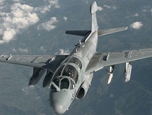 In a possible military attack on Iran, Israel would not only target nuclear facilities but likely also missile and military bases to prevent retaliatory attacks by the Iranians, international experts told CNN in a report published Wednesday.
In a possible military attack on Iran, Israel would not only target nuclear facilities but likely also missile and military bases to prevent retaliatory attacks by the Iranians, international experts told CNN in a report published Wednesday.
Israel would have eight potential targets if it moved forward with an attack on Iran, according to the CNN report, which cited Emily Chorley, a nuclear expert at the London-based defense analysis firm Jane’s.
The primary targets, according to Chorley, would include the Natanz and Fordo nuclear enrichment facilities, the Isfahan uranium conversion site, and the Arak nuclear compound.
The nuclear expert told CNN that the Israelis would also seek to target two secondary sites, the Tabriz and Imam Ali missile bases, “to prevent a retaliatory missile attack” on Israel.
The Parchin military base, east of Tehran, which became controversial after the Iranian regime denied International Atomic Energy Agency inspectors entry into the base, could also be a possible target for Israel.
Lastly, Israel might also target the Bidganeh military base, which suffered a mysterious blast in November that left 17 people dead including Gen. Hasan Moghaddam, considered to be the architect of Iran’s missile program.
Experts told CNN that the fact that there were several targets, that they were dispersed and that most of them were heavily fortified would make an attack on Iran much more complicated for Israel than the strike on the Iraqi nuclear reactor in 1981 or Israel’s suspected attack on a Syrian reactor five years ago.
The experts say an Israeli attack on Iran would involve more than 100 planes, ranging from fighter aircraft to refueling tankers, that would need to fly hundreds of miles to bomb the intended targets.
The IAF would most likely need to attack Iran with fighters jets — the F-15I and the F-16I — instead of firing missiles from submarines, Ephraim Kam, deputy director of Israel’s Institute for National Security Studies, told CNN.
“In order to create proper damage to the nuclear plants, you need extremely accurate weapons,” Kam said. “I don’t know that the missiles are accurate enough.”
The Israeli fighter planes lack the range to be able to reach most of the potential targets, so Israel would also need to use a tanker aircraft, of which it has at least seven, Douglas Barrie of the International Institute for Strategic Studies in London told CNN.
The fighter aircraft would be loaded with bunker-busting, 5,000-pound bombs to “go after hardened and buried sites,” Barrie said.
Chorley told CNN that Isfahan and Arak were above ground and “relatively vulnerable to aerial attack.” However, she said Natanz was buried deep underground, under six feet of concrete, making it “very hard to penetrate.”
The expert said Fordo, near Qom, was “even more difficult” because it was deep inside a mountain, and dropping a bunker-busting bomb on the site might only further protect it if it destroyed the entrance without destroying the facility.
“It’s questionable whether Israel is capable of destroying it in an air-launched attack,” Chorley told CNN.
Since Fordo is believed to be enriching uranium to higher levels than the other facilities, “just getting Natanz and Arak without getting Fordo wouldn’t be worth the risk,” she said.
All four nuclear facilities are protected by S-200 and Hawk surface-to-air missile batteries, Jim O’Halloran, another expert at Jane’s, said.
In an interview with Danish television station TV2 on Thursday, Iranian Foreign Minister Ali Akbar Salehi said that if Israel decided to strike nuclear facilities in Iran, his country would respond forcefully.
“If Israel ever makes this mistake, this will be its end. The Israeli are well aware of this,” Salehi said.
Echoing what Israeli and U.S. officials have said in recent months about possible military action against Iran, Mohammad Javad Larijani, an adviser to Iranian Supreme Leader Ayatollah Ali Khamenei, told CNN on Thursday, that when it came to an Iranian counter-attack, “every possibility is on the table,” including a missile strike on Israel and the closing of the Strait of Hormuz.
Larijani said if the West wanted more transparency from his country over its contentious nuclear program, than Iran expected to receive more cooperation.
“The equation is simple. The Western community can ask us for more transparency. What we want in place of that is cooperation,” Larijani told CNN. “I mean, this is two parallel lines. One step transparency from us, one step cooperation from (the) West. Because we have full total suspicion of the American and Western intentions.”
Meanwhile, the U.S. State Department on Thursday denied reports published earlier this week that U.S. Secretary of State Hillary Clinton had issued an ultimatum to Iran, through the Russians, saying it had one final chance to resolve its nuclear crisis through diplomatic means before facing possible military action.
According to a report in the Russian daily Kommersant, Russian diplomats were quoted as saying that Clinton asked Russian Foreign Minister Sergei Lavrov on Monday to inform Iran that it had a last chance to engage in talks with the P5+1 group — comprising the U.S., Britain, Russia, China, France and Germany — to end the conflict over its nuclear program. If this fails to happen, Iran can expect to suffer an attack on its nuclear facilities within months, the diplomats told the Russian newspaper.
IDF Chief of Staff Lt. Gen. Benny Gantz, meanwhile, set out Thursday night on a visit to the U.S. and Canada. Gantz is expected to hold meetings with government and defense officials in his host countries during which regional developments, including a possible attack on Iran, will be discussed.
In related news, U.S. Admiral Jonathan Greenert, chief of naval operations, said on Thursday that the navy was doubling the number of minesweeping ships and helicopters in the Persian Gulf. The move was made in preparation for the possibility that Iran may close the strategic Strait of Hormuz, a key route through which a fifth of the world’s traded oil travels.
{Israel Hayom/Matzav.com Newscenter}












Nice picture, but Israel doesn’t have any EA-6Bs.
Do what R’ shteinman said-pray